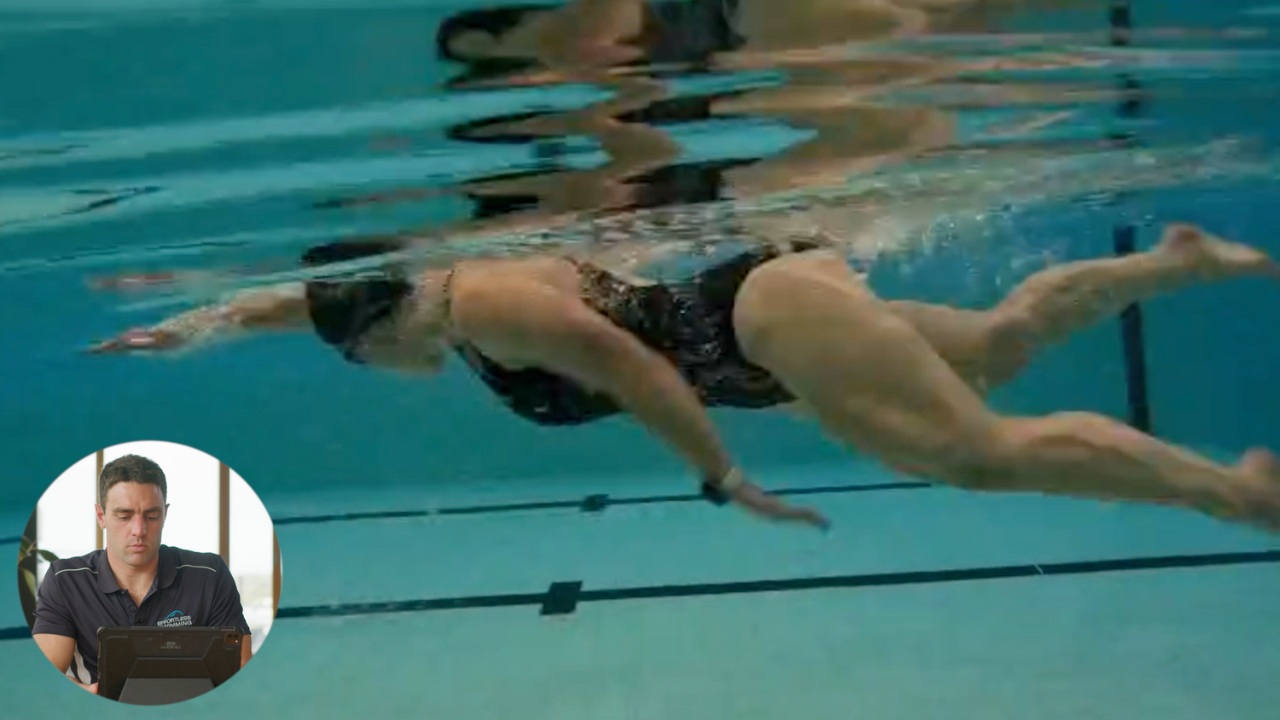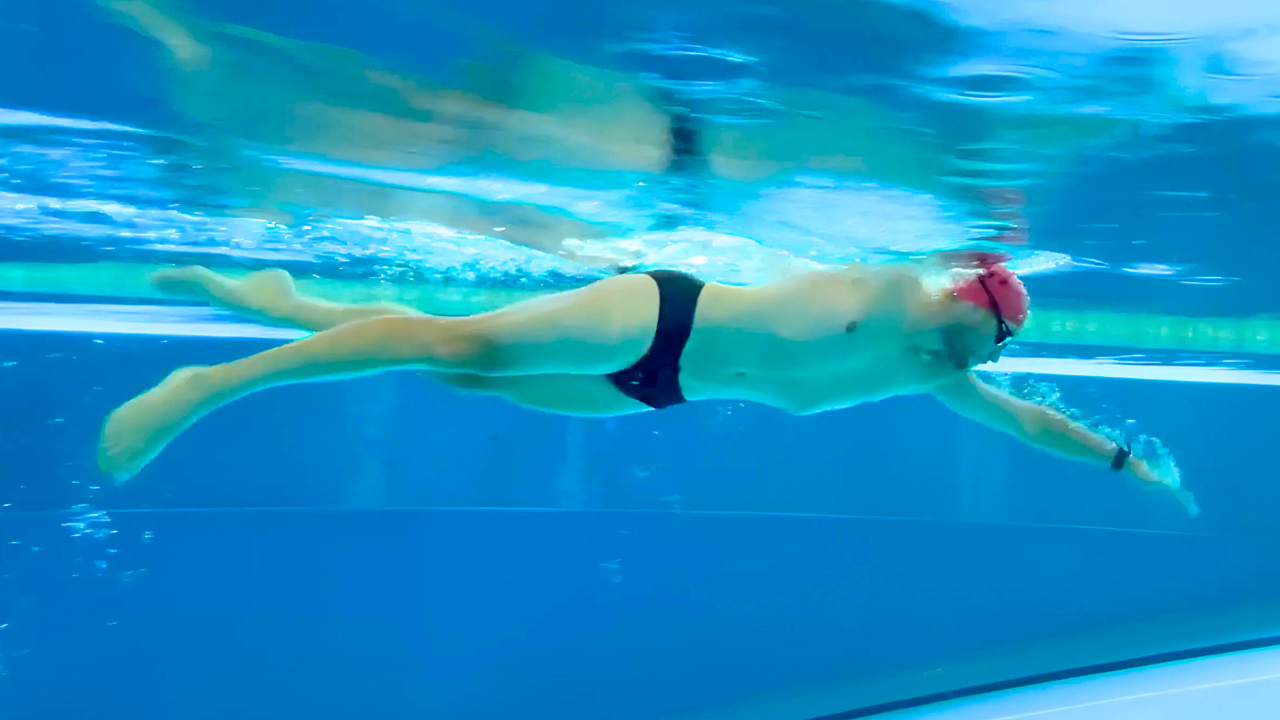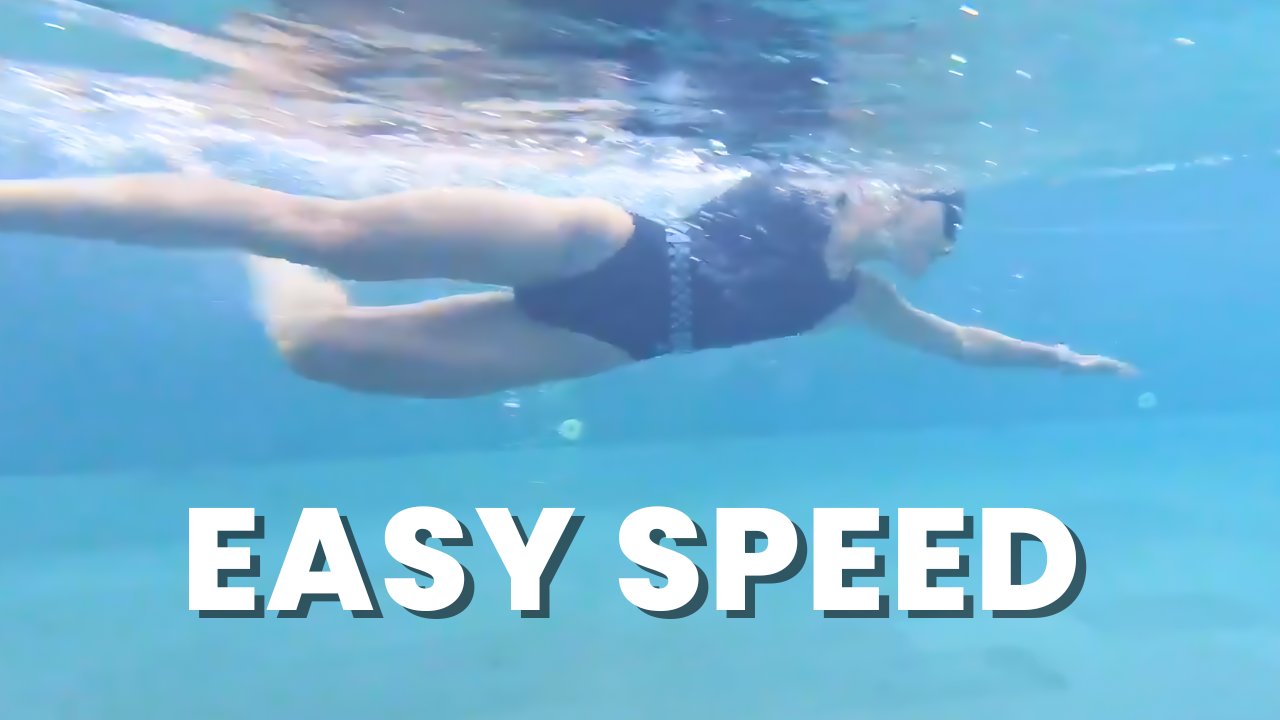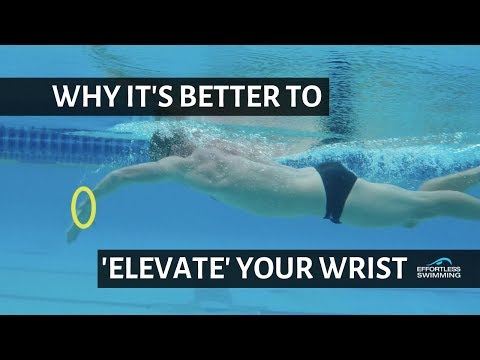We look at a triathlete who has competed in Ironman events and is currently doing shorter distance triathlons. His Ironman swim PB is 56 minutes, so what can he do to get it in the low 50’s?
– Stroke rate (remove/reduce the pause in the reach)
– Improve the catch
– Fix the breathing (going too far and causing the shoulders to over-rotate)
Transcription:
I’d want to see him come over a little bit quicker. So let’s say he can get the arm over in 0.4 of a second instead of 0.5 of a second. That is one thing that will just increase his stroke rate really without any extra effort and without changing too much at all.
Hey, Brenton here. Welcome to Feedback Friday. In today’s episode, we’re looking at a triathlete focused currently on shorter distance triathlons, but has done some longer ones. Now his 3.8K swim time PB is 56 minutes. So swimming well here, and in probably the top 20, 10-20% the field there with that sort of time. So a lot of things that this swimmer here is doing really well and we’re going to look at what he can improve on to swim faster and continue to bring that time down from 56. There’s no reason why he couldn’t get it down to the low 50s over the next six to 12 months. Focusing on a couple of things.
So if you haven’t seen these videos before, in our Feedback Friday videos, we analyze someone’s stroke and we look at the two or three things that can make the biggest difference with their speed and efficiency. So make sure you like and subscribe if you do enjoy it, and share this video with someone that you know who are looking to swim faster.
So in this video here, if we have a look from under the water, he’s doing a lot right now. The things that sort of stand out to me here that I’ll be looking to focus on, one part of it is going to be the catch. So the start of the catch and just improving on the catch position. Probably a little bit less of a reach and extension out in front. So in this phase of the stroke, I think he can shorten this slightly. And the third thing I’d look to do is over time, increase the stroke rate, and be a little faster with the recovery.
To me, they’re the things that sort of stand out because we can see that the body position is good, his head position’s good. Alignment, he’s entering in line with his shoulders and extending forwards, and some parts of the catch, it’s not like he’s got a bad catch, but we can certainly improve on that.
So the first thing I’d look to do, and we want to focus on these things in the right order, so there’s no point just trying to change the catch if there are a few other things going on. Now the first thing I’d look to do is possibly just shorten the reach phase of the stroke. So as he’s reaching forwards here, it looks like he might be trying to overreach a little bit. So as he enters and extends forwards, it looks like he’s reaching out a long way in front there. Same on the left hand side, we’re sort of seeing it there.
Now, we partly see it because of … you can sort of see, it looks like he might just lose his balance slightly there, but from the front, you can see just on some of these strokes … Yeah, I reckon there’s a little bit, possibly a little bit of over rotation going on. It’s not too bad, but on his breathing strokes, so that’s 43, so that’s fine. We usually want that sort of 35 to roughly 50 degrees, but like on the breathing stroke, I think he just goes a little bit far there.
So he’s definitely sort of overreaching. Now that’s almost 70 degrees rotation and you can just see how it sort of throws the balance of the body off there. But in general, what I’d look to do there is just … Yeah, you want to be long in the stroke, but let’s say you’re reaching out to 100% of your capable reach or extension, 100% of your length there. What that’s going to do to you is just throw your balance off slightly and it’s going to make it hard to use the stronger muscles through the back and shoulder there because the shoulder is so far forwards there.
What I’d aim here is just bring it back a couple of percents, like bring it back 5% in terms of the reach. That’s going to put you much more in control and give you much better balance and stability through the stroke. So number one, I would just shorten the reach a little bit. So don’t try and go all the way out in front. Just shorten that slightly. So that’d be the first thing. In terms of drills for that, you can certainly do drills for it, but I think just from an overall swimming perspective, that’s something you can change in your normal strokes. So no need really for drills from there.
What that’s going to allow him to do is then just improve on this catch phase of the stroke. So he still holds good water. And if you’re swimming 56 for your 3.8K swim, you’re swimming well. But he can get more out of each stroke here. So you can see that at the start of the catch position, now this is being a little bit picky, but it’s going to be worth changing. So you can see at the start of the catch that the elbow’s actually lower than the fingertips just slightly. We want to try and change it so we’ve got the fingers below the wrist, wrist below the elbow.
I didn’t draw that very well. So fingers below wrist, wrist below elbow. In that position, it’s so much easier to get a better catch. Now what we tend to see, if you’re starting the catch with that slightly dropped elbow position where the elbow’s deeper than the rest of the hand, more times than not, the hand and the forearm are just going to sort of continue that way, and the elbow will continue to drop through the catch.
And you can actually see it here, how the forearm is there, yet fingers are down. So this is good, but he’s not using his forearm and his hand to really press back very well. So there’s a big opportunity there to basically improve on it. And once he gets that hand and forearm in a better position to get more surface area pressing back, he’s going to get a lot more propulsion out of that left arm. And you can also see it from here. So that’s just that slightly dropped elbow catch.
So that’s one thing that I would work on. But as I said, he’s got to shorten the reach phase a little bit in order to be able to do that. Same thing on the right hand side. It’s a slightly better starting catch position, as in the fingers are the deepest part of the arm, but there, once he’s entered, and it just tends to go a little too deep. So we want to try and get those fingers just below the shoulder.
So again, I’m being a bit picky here, but we want to just try and get these things right because it does make a difference. So I’d just look to keep the hand up a little bit higher and just make that sort of starting catch position a little bit more pronounced. Now through this right hand catch, that’s probably better. You can see that’s more surface area that he’s got, and he probably gets that little bit more out of the right one.
So this is on its way to a better catch position. So we probably just want to try and get that catch a little bit earlier. You can just see because it does go down a little bit too deep, stays kind of straight. Maybe a little dropped elbow in the beginning. So we want to work on that.
Now you’ve probably seen our previous videos, the YMCA drill is great for that. Another drill you can do, and I’ve been giving this to a couple of people lately, is the setup drill. So you can see it in this video here. With the setup drill, you’re basically just isolating the catch. You’re just going from back out here, to then just dropping the hand and forearm down, and then coming back up.
So you’re just practicing that part of the stroke there, and what we want to try and do there, it’s just developing motor patterns and developing muscle memory to be able to sort of know … so your body knows what it’s like to get that part of the stroke right. So the setup drill, it’s a pretty simple one, but it can really just give you a sense of what you’ve got to do there, in that part of the stroke.
So that would be the … well, the second thing, so one, maybe not reaching out quite as far. Number two looking to just work on that catch a little bit there. And the third one would just be a slight increase in stroke rate over time. So his stroke rate here, and it sort of changes throughout the different videos, but it’s sort of in that mid to low 60 strokes per minute. Now if you swim 56, those guys that are doing the … The pros, those guys are hitting your sort of 47 to 50 or even like low 50s. Most of them are going to be in that 70 to 80 stroke rate range for the 3.8K swim. Especially if it’s sort of a wetsuit swim as well. It’s definitely going to be up in that 70 to 80 degree range.
So it’s going to be difficult … it’s probably going to be difficult for him to hold that same stroke rate of 60, say 63, 64, in that Ironman distance swim and try and bring the time down to a low, let’s say 51, 52, because with that stroke rate, he’d have to really increase the distance per stroke that he’s taking here. Now yeah, he can certainly do it with an improvement in the catch, but not enough, I don’t think, to really get him down to that low 50 range.
So the other factor, the other part of your speed is stroke rate. So when we look at how do you swim faster, a combination of, well, it’s basically how far you travel with each stroke and the rate at which you take those strokes. So put simply, adjusting those numbers are what is going to help you swim faster and we’d be remiss to not look at the stroke rate there.
So what he can do to increase that stroke rate, well, I think what we just looked at will increase it a little bit. So if he doesn’t reach out quite as far, there’ll be a little bit less of this sort of pause and delay in the catch phase of the stroke. So as you look at it here, there’s just occasionally, yeah, maybe a bit too much of a pause in some aspects of that reach. So that’ll just help him get into the catch a little bit sooner.
But the other thing I’d be looking to do there too is speed up the recovery a bit. So if we look at the recovery, to me he’s just spending that little bit too long above the water. So if we’re talking race pace, we’re looking at the arm coming over here. All right, he can certainly just speed that up a little bit. So we’re looking at about half a second per recovery there. I’d want to see him come over a little bit quicker.
So let’s say and get the arm over in 0.4 of a second instead of 0.5 of a second. That is one thing that will just increase the stroke rate really without any extra effort, and without changing too much at all. So there’s a number of things you can do to increase the stroke rate there without really pulling through faster because you don’t want to get to that point where you’re just spinning the wheels and slipping through the water. So for him it’s a faster recovery, little bit less time spent in that glide phase of the stroke. So just getting into the catch a little bit sooner, and that’ll probably do it for him.
So I’d keep it really simple. I’d focus on those couple of things and that can certainly help him bring that time down. Now, especially if he’s focused on the shorter distance races like you mentioned in the comments, then he would definitely want to be getting that stroke rate up. If he’s doing a 400 meter or a 750 meter swim, then that stroke rate, over time, let’s say the next six to 12 months should be up around at least above 70, but we’re probably looking at around mid-70s if he really wants to be in the top five to 10% of of the field there.
So that’s what I’d be looking at. Now, I hope you enjoyed this video. Like and subscribe, and I’ll see you next week with another Feedback Friday.









